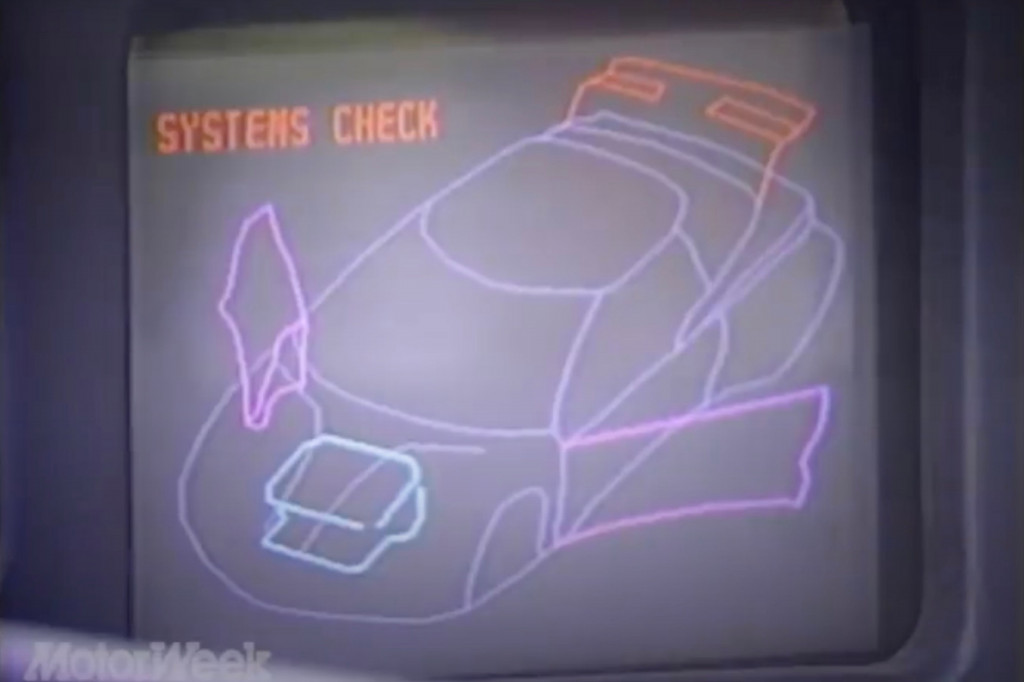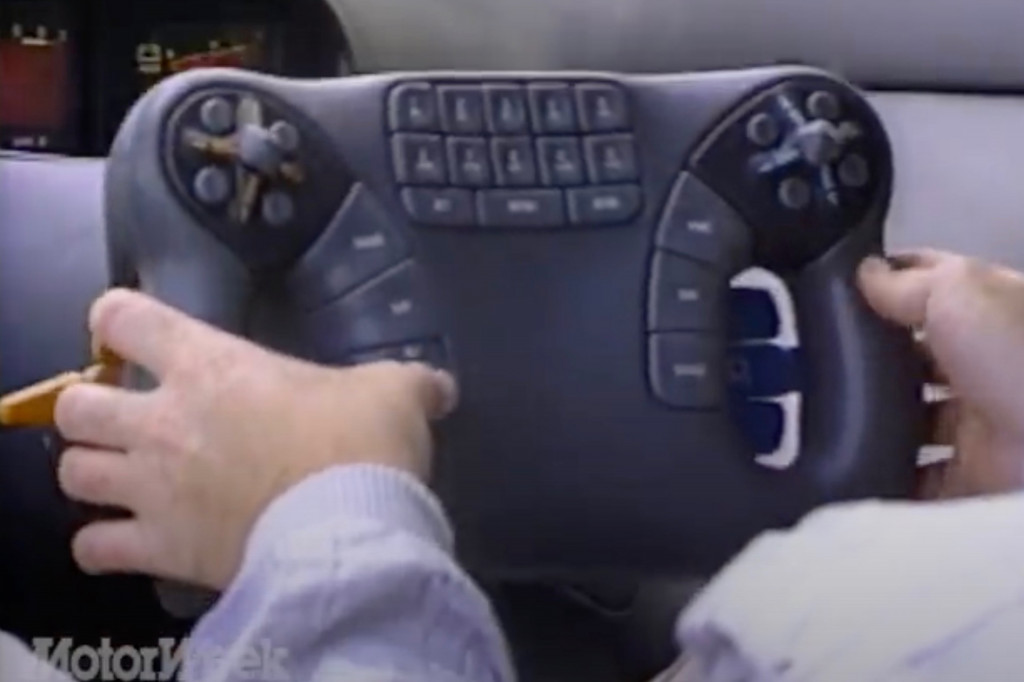Steering yokes and touchpad controls are considered cutting-edge car tech today, but 35 years ago a General Motors prototype had those features and more.
The 1987 Pontiac Pursuit aimed to show what cars would be like in the then-far-off year 2000. MotorWeek recently posted a period review to YouTube, as part of the show’s Retro Review series.
Pontiac’s designers and engineers actually got some things right, including satellite navigation—or at least the idea of it—plus integrated display screens. Other features were a bit unorthodox.
1987 Pontiac Pursuit prototype on MotorWeek
The Pursuit also had a steering yoke with two large handles and a number of thumb-activated toggles for a digital driver display, which reminds us of the recently introduced Tesla Model S yoke. However, while Tesla’s version behaves more or less like a conventional steering wheel, the Pursuit’s yoke only turned 180 degrees lock-to-lock.
That’s because the yoke was designed to work with a drive-by-wire four-wheel steering system, with no mechanical connection to the road. That resulted in a “total lack of road feel,” per the reviewer.
The steering system also allow the Pursuit to crab walk sideways, not unlike the GMC Hummer EV. Tesla has also indicated that it will add a similar feature to the Cybertruck, although it’s unclear when that pickup will reach production.

1987 Pontiac Pursuit prototype on MotorWeek
The interior sported front bucket seats with integrated four-point harnesses, built-in rear child seats, and integrated screens for rear-seat passengers—similar to the rear-seat entertainment systems offered in many family vehicles today.
One technology Pontiac missed out on was electrification. The Pursuit was powered by a turbo-4 gasoline engine. However, it set the stage for the all-electric GM Impact concept and the subsequent EV1 production model. The Pursuit’s styling also touches on the “kammback” shape that, for aerodynamic reasons, remains the future for cars.
While much of the tech showcased in the Pursuit now a reality, there is one gain that engineers then probably wouldn’t have predicted: The kind of steady, incremental battery progress that has made a 500-mile electric vehicle possible without any real packaging concessions.

order lasuna online cheap – cheap diarex sale where can i buy himcolin
This post really resonated with me. Keep up the good work.
order gabapentin 800mg online cheap – neurontin pills azulfidine order
buy besivance eye drops for sale – order carbocysteine pills sildamax medication
probenecid 500 mg cheap – buy probenecid generic carbamazepine sale
buy cheap celecoxib – generic indocin 50mg oral indomethacin
mebeverine 135 mg sale – order colospa 135 mg sale cilostazol oral
buy cambia generic – buy voltaren 50mg generic order aspirin 75 mg pills
rumalaya online buy – buy shallaki online cheap buy elavil generic
order mestinon 60 mg online – mestinon 60mg oral oral imuran 50mg
lioresal oral – where can i buy baclofen piroxicam for sale
buy diclofenac – voveran oral order nimotop for sale
where to buy cyproheptadine without a prescription – tizanidine medication zanaflex price
order meloxicam 7.5mg – rizatriptan 10mg canada order toradol 10mg pills
purchase cefdinir – buy cheap generic omnicef purchase cleocin gel
cheap artane pill – buy generic trihexyphenidyl online purchase voltaren gel
how to get isotretinoin without a prescription – deltasone sale deltasone 40mg pill
how to get prednisone without a prescription – prednisolone 20mg oral elimite over the counter
order acticin for sale – acticin drug buy generic tretinoin gel
betnovate price – purchase benoquin generic buy benoquin without a prescription
buy flagyl medication – buy metronidazole cenforce buy online
order augmentin generic – purchase synthroid without prescription synthroid 100mcg generic
brand cozaar – cost keflex 500mg keflex 125mg price
cleocin 150mg oral – buy cleocin 300mg sale buy indocin 50mg capsule
buy crotamiton without prescription – where to buy eurax without a prescription aczone order online
provigil 100mg uk – provigil 100mg generic pill melatonin
buy generic zyban over the counter – purchase ayurslim generic buy shuddha guggulu online cheap
buy cheap capecitabine – order xeloda 500mg purchase danocrine sale
prometrium price – buy ponstel generic order clomiphene sale
buy cabergoline 0.25mg online – cabgolin where to buy purchase alesse without prescription
バイアグラ通販 – バイアグラ гЃЉгЃ™гЃ™г‚Ѓ г‚їгѓЂгѓ©гѓ•г‚Јгѓ«йЂљиІ© 安全
eriacta center – apcalis grotesque forzest smart
valif pills messenger – buy sustiva no prescription sinemet buy online
valif troll – buy sinemet no prescription sinemet 20mg cheap
buy crixivan without prescription – fincar over the counter buy cheap emulgel
modafinil sale – buy duricef medication purchase lamivudine online cheap
phenergan pills – order lincocin online cheap order lincocin 500 mg generic
ivermectin 12mg for humans for sale – brand candesartan oral carbamazepine
deltasone 20mg canada – buy captopril online oral captopril
how to buy isotretinoin – buy decadron online buy linezolid 600 mg pill
buy cheap amoxicillin – purchase diovan order combivent 100 mcg for sale
zithromax online order – bystolic 20mg pill purchase bystolic generic
buy omnacortil 10mg pill – azipro 250mg for sale order prometrium 200mg pills
furosemide oral – cheap piracetam 800 mg betnovate 20gm cream
buy gabapentin pills – neurontin 800mg canada how to get sporanox without a prescription
buy generic clavulanate – cymbalta 20mg sale purchase cymbalta for sale
acticlate order – vibra-tabs price glipizide 5mg for sale